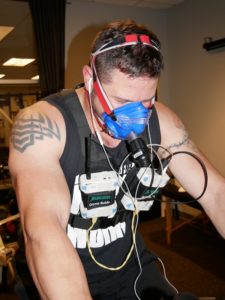The Myth of EPOC
One of the big reasons for people performing interval training is Exercise Post Oxygen Consumption (EPOC) to enhance fitness and weight loss by burning more kcal (calories) after exercise.
The theory is that interval training, commonly described as High-Intensity Interval Training (HIIT), will burn more kcal than cardio training and will leave the body’s metabolism in a heightened state of after-burn for hours.

You can measure energy expenditure in real time to answer this question!
If this is the reason you are performing HIIT regularly, you might want to keep doing it, yet for different reasons. First off, in terms of energy expenditure, a steady-state workout in your cardio zone compared to the same amount of time in an HIIT program burn almost the same number of kcal! What is different is how you consume them and what you get out of the training session. Also, if your aerobic training is at a brisk walking pace, and your HIIT is maximum effort for each interval, then there will be some difference in favor of the HIIT.
The real reason to perform HIIT is the elevation of the Anaerobic Threshold or the steady-state maximum speed in your cardio zone. So, in car terms, if you can cruise at 50 mph, you are going to burn a certain amount of gasoline. If you can take that steady speed to 70 mph, then it is just that much more gasoline over the long haul. And since most people are going to perform more cardio than HIIT, that is the specific activity that will burn more kcal resulting in better health and weight loss.
The research does support a very minor increase in EPOC after interval exercise, but it is only around 8-10% of the total kcal burned and does not last for very long. So, if a 140-pound woman burns 325 kcal in a 20 minute HIIT session, she is going to burn 33 more kcal before she is metabolically recovered. And the fitter you get, the shorter and less intense the after-burn. I have tested some MMA fighters and other professional athletes who performed a maximal VO2 test, and their metabolism was back to normal in 5 minutes! Some recent research shows this 8% gain only lasts 15 minutes.In fact, moderate cardio training and HIIT apparently have the same short after-burn both in total kcal and time.

Metabolic testing precisely determines kcal burn both from exercise and after exercise.
The best way to use HIIT is a 1 day of HIIT to 2 or 3 ratio regular “cardio” or aerobic training days. That way, you increase your cruise control speed, then actually can tap into more fat at a higher rate in the cardio sessions. While the grandiose claims of EPOC being substantial are mostly a marketing myth, the benefits of HIIT increasing AT or metabolic cruise control and based in research reality!
Selected References
Bersheim, E. and Bahr, R. (2003). Effect of exercise intensity, duration and mode on post-exercise oxygen consumption. Sports Medicine, 33, 14, 1037-1060
Elliot, D.L., Goldberg, L., and Kuehl, K.S. (1988). Does aerobic conditioning cause a sustained increase in metabolic rate? American Journal of Medicine and Science, 296(4), 249-251.
LaForgia, J., Withers, R. and Gore, C. (2006). Effects of exercise intensity and duration on the excess post-exercise oxygen consumption. Journal of Sport Sciences, 24, 12, 1247-1264.
Schaun, G.Z. Pinton, S.S. Praia, A.B., and Alberton, C.L. (2018)Energy expenditure and EPOC between water-based high-intensity interval training and moderate-intensity continuous training sessions in healthy women. Journal of Sport Sciences. 36(18):2053-2060.
Thornton, M.K. and Potteiger, J.A. (2002). Effects of resistance exercise bouts of different intensities but equal work on EPOC. Medicine and Science in Sports and Exercise, 34(4), 715-722.

